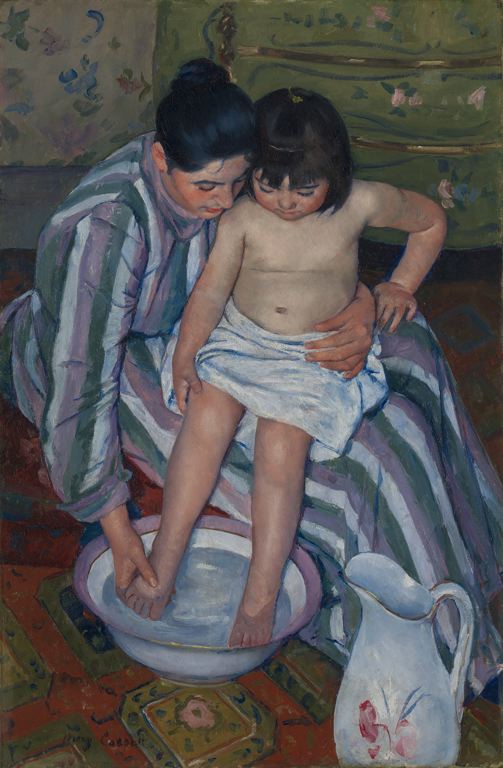When I first encountered the warm voluptuousness of Mary Cassatt’s paintings, it annoyed me. Then I realized the artist had never married, living much of her life frequenting Paris salons, arguing about the merits of Velasquez, and putting Edgar Degas in his place. (One biography, in an effort to dispel rumors that Cassatt had been Degas’ mistress, cited Degas’ misogyny; Cassatt wouldn’t have stood for that.) The matronly sentimentality of images like The Child’s Bath seemed okay in light of Cassatt’s gutsy, single childlessness. In fact, such images began to feel like clever inside jokes. Their femininity, something Cassatt must have been expected to embody or at least embrace, was actually a convention in which she had only a peripheral stake. She used its tropes and material maybe even spitefully, while experimenting with other things, like becoming the only recognized American Impressionist.
There’s an homage to Cassatt in sculptor Rachel Lachowicz’s current exhibition at Shoshana Wayne Gallery in Santa Monica. It’s a circular stack of blocks as rosy as any Cassatt-rendered flesh, made of soap and shaped like Allan Kaprow’s Fluids, only less precarious and more solitary. It also smells great. Lachowicz has used bergamot essence, and the strength of the scent makes touching the blocks all but irresistible. They’re begging to be a sensual experience on every level.
Each sculpture in the exhibition uses as its material something conventionally, or cosmetically, feminine. In addition to the rosy-pink soap, there’s pressed eyeshadow in tins, blue and purple cosmetic compound, brutally red lipstick wax, and tissue paper lining metal shoe boxes. But like Cassatt, Lachowicz occupies a limited material vocabulary of the feminine in a way that’s conflicted and aimed at bigger, knottier questions.
Lachowicz spent a significant portion of the 90s “redoing” men in women’s material. Her lipstick and wax Sarah, an impeccably red remaking of Richard Serra’s (Season 1) lead sculpture, One Tom Prop, appeared in Kirk Varnedoe’s 2003 ode to abstraction, Pictures of Nothing. Does Lachowicz suggest that abstraction “is in some sense impossible”? Varnedoe asks, wondering if her insistence on contextualization nullifies Serra’s venture into the brute power of material. “[I]s this in fact the end of abstraction? The arrival of something like the Lachowicz?” This may be the wrong question, however. A red lipstick Serra/Sarah, while certainly a jab at austerity, doesn’t have to be about the end of anything. Instead it can be and, I think, was about sharing space. Could the clean, seemingly masculine clarity of minimalist sculpture be something a woman working in the 90s could occupy while still being honest about her own position in the world?
In Lachowicz’s current exhibition, her first with Shoshana Wayne since 2005, she’s answered this question in the affirmative and moved on, though with some concessions. Her affection for the clean grids, angles, and surfaces of minimalism permeates each work, though no male minimalists warrant direct mention (in the past she’s cited Sol LeWitt, Carl Andre, Donald Judd, and others)–in fact, the only artist openly cited is Cassatt, someone to whom Lachowicz owes no readily apparent formal debt. Yet more than ever before, the point here seems to be transparency. Unlike Serra or Andre, artists who bask in a sort of industrial transcendence, turning rough materiality into magical immateriality, Lachowicz is not working in mystery; she’s working with tangible, hands-on stuff.
Cell: Interlocking Construction consists of a various angular Plexiglass boxes that climb up the gallery’s back wall. Each contains mountains of cosmetic powder, more synthetic than paint pigment, but still grittily seductive. Against the opposite wall, the cardboard boxes that the plexi shapes arrived in approximately mirror Interlocking Construction. This sort of gesture might seem self-referentially gimmicky in a lesser exhibition. But Lachowicz makes it feel like calculated honesty. That it’s aesthetically pleasing is noteworthy, but as a by-product of calculation.
In the back gallery, two striking canvases sporting splashes of red lipstick wax on red lipstick ground, flank a series of “production stills” that show Lachowicz and her team pouring thick red over white canvases. The stills aggressively assert that these lush red “pour paintings” were made–by a woman artist working in a studio and executing specific processes.
In her manuscript for the chapbook Diana and Persis, Louisa May Alcott modeled a character after Cassatt. Not-so-clandestinely named “Miss Cassal,” this character, like the real Cassatt, has a piece rejected from by the Paris Salon. Writes Alcott, “I am told that men are jealous, and that [Miss Cassal’s work] was refused because of its boldness and power.” Nonetheless, “she smiles and paints on tranquilly, content to be felt if not seen.” But according to biographer Nancy Mowell Mathews, the real Cassatt did not handle rejection so demurely. The real Cassatt felt rage, and wanted to be seen and felt. So does Lachowicz, and her new work asks to be seen on every level: for its material, its process, its curation, its smartness. Seeing art for what it is doesn’t have to undercut the way it feels, and this work feels spot-on and dead gorgeous.
